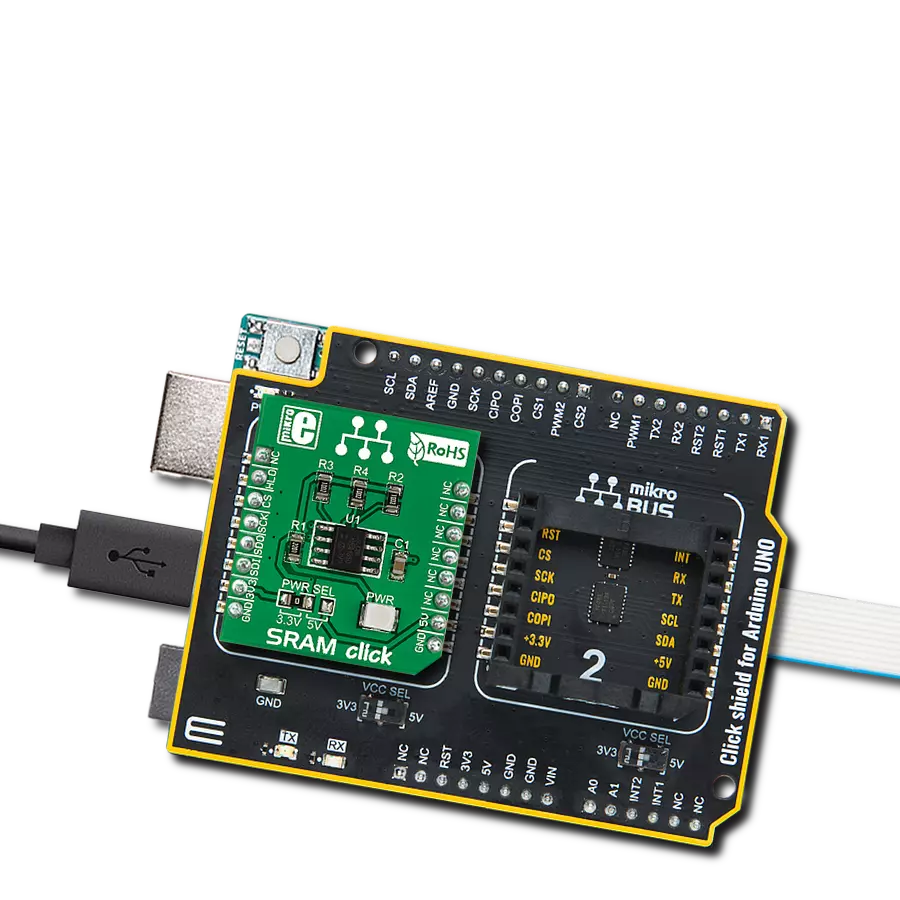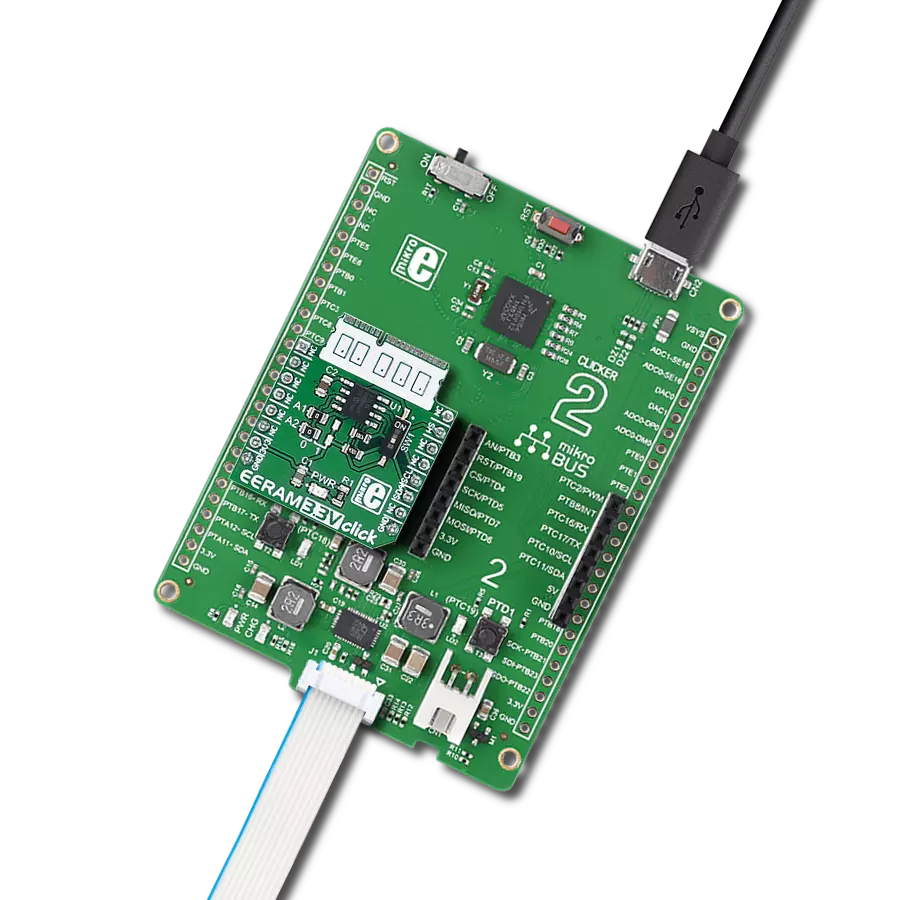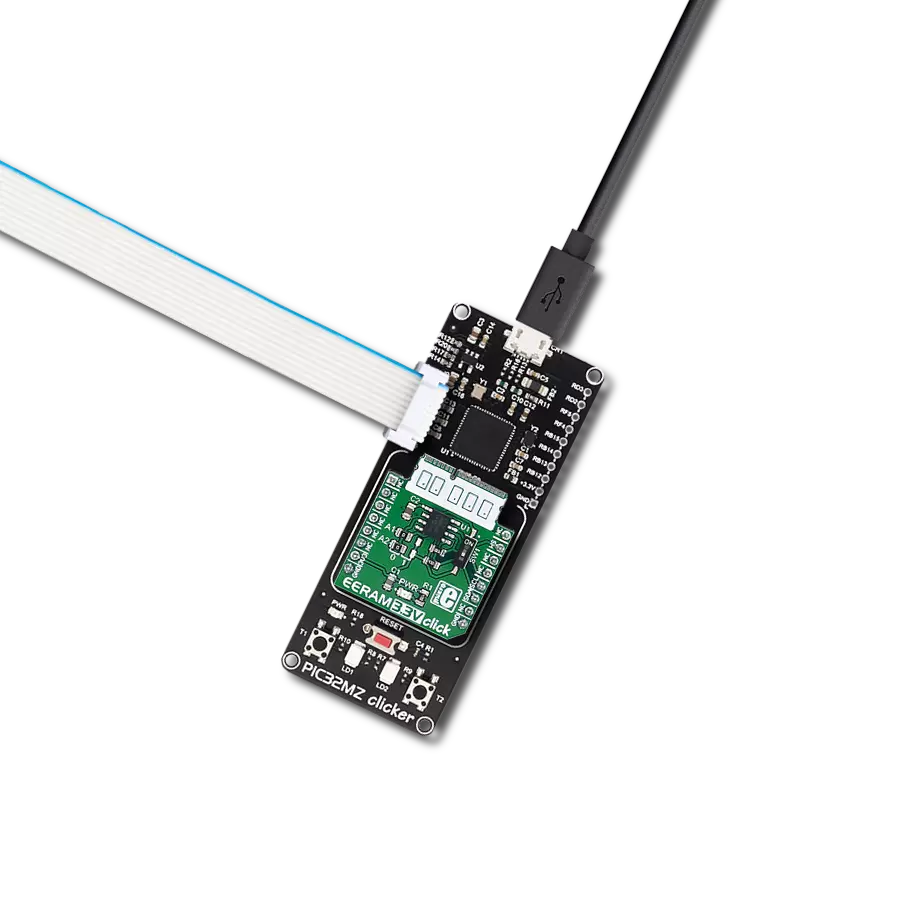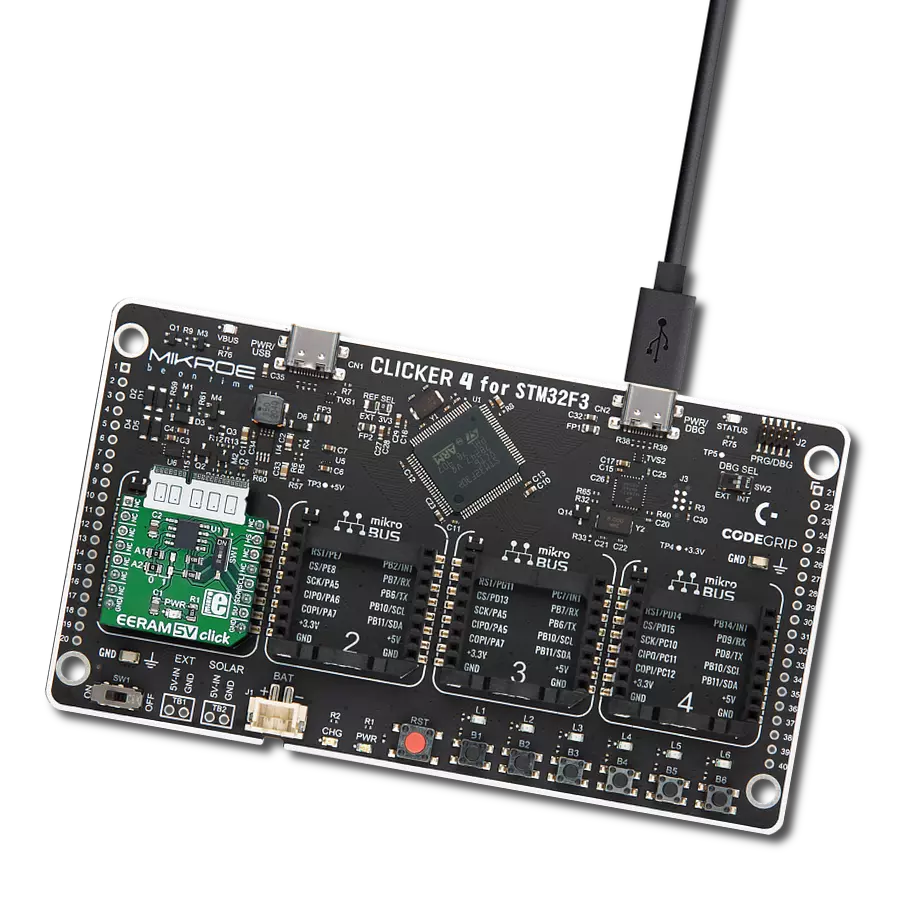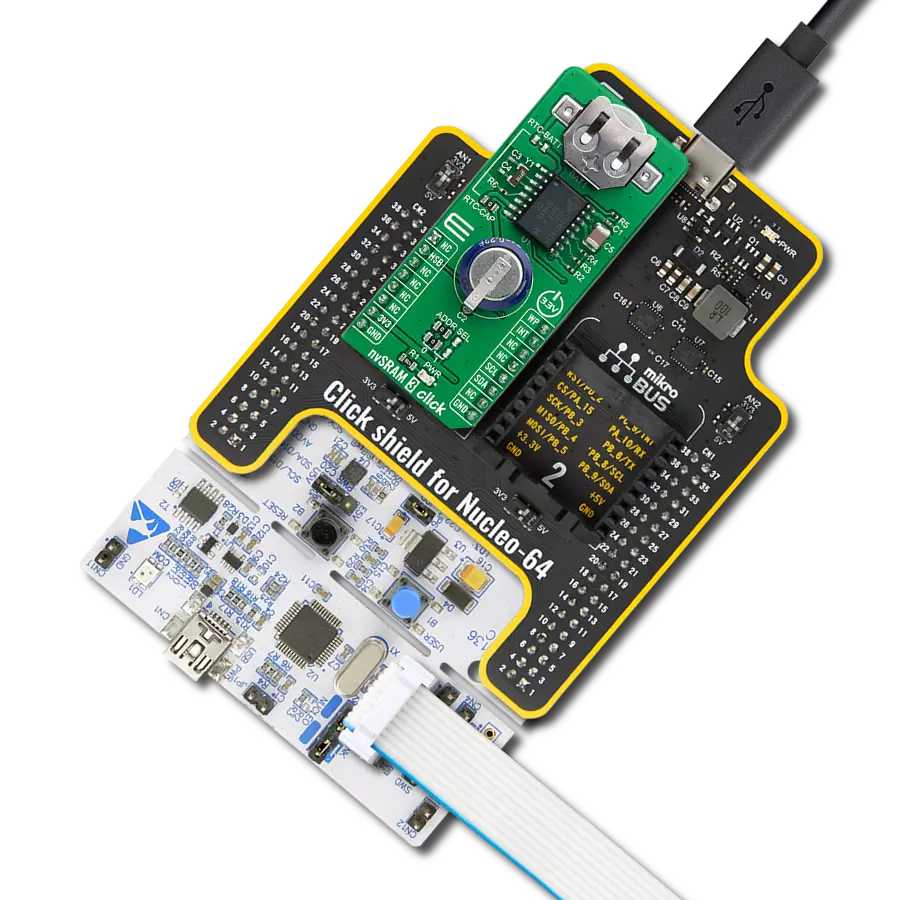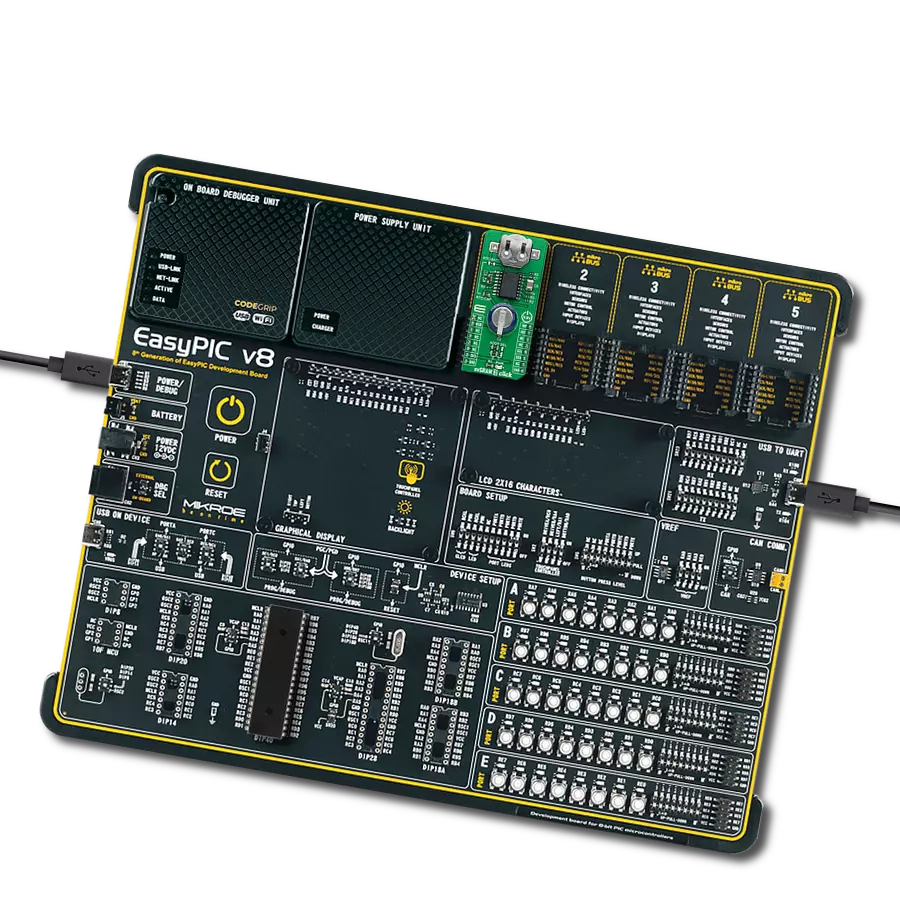Our SRAM memory excels at delivering real-time responsiveness in a variety of devices and systems
A
A
Hardware Overview
How does it work?
SRAM 2 Click is based on the ANV32A62A, an SRAM memory from Anvo-Systems Dresden. It uses nvSRAM which is ordinary SRAMs with the ability for self-sufficient, automatic backup of SRAM-data in an internal FLASH, All Read/Write operations are addressing the SRAM array only. From a user point of view, nvSRAM appears as ordinary SRAM. SRAM are fast, energy efficient and does not wear-out while R/W operations. This explains the superior speed and the unlimited R/W endurance of nvSRAM. Data transfers automatically to the non-volatile storage cells when power loss is detected or in any brown out situation (PowerStore). As long as power will be supplied within operating conditions all data stay volatile in the SRAM cells. SRAM 2 Click is using a standard two-wire interface (I²C) and is functional similar to serial EEPROMs or FRAM. The
addressing requires a 13 bit address out of the 2-byte address of the two-wire protocol. The jumpers ADDR SEL are device address inputs to select 1 of up to 4 devices of the same type on the same I²C bus. To select one device the hard wired addresses on the 2 pins have to match with the related bits in the slave address. This SRAM also features PowerStore operation which is a unique feature of the SONOS technology that is enabled by default on the ANV32A62A. During normal operation, the device will draw current from VCC for circuit operation and to charge a capacitor connected to the VCAP pin. This stored charge will be used by the chip to perform a single STORE operation in case of power down. If the voltage on the VCC pin drops below VSWITCH, the part will automatically disconnect the VCAP pin from VCC. A STORE operation will be initiated with power
provided by the VCAP capacitor. If a write operation is in progress all data of complete written pages are valid. Only the last incomplete written byte will be ignored. With the following Power Store execution these data become non-volatile. To reduce needless non-volatile stores, Power Store operation will be ignored unless at least one write operation has taken place since the most recent STORE cycle. The PowerStore Operation is valid for the complete memory array. This Click board™ can be operated only with a 3.3V logic voltage level. The board must perform appropriate logic voltage level conversion before using MCUs with different logic levels. Also, it comes equipped with a library containing functions and an example code that can be used as a reference for further development.
Features overview
Development board
EasyAVR v7 is the seventh generation of AVR development boards specially designed for the needs of rapid development of embedded applications. It supports a wide range of 16-bit AVR microcontrollers from Microchip and has a broad set of unique functions, such as a powerful onboard mikroProg programmer and In-Circuit debugger over USB. The development board is well organized and designed so that the end-user has all the necessary elements in one place, such as switches, buttons, indicators, connectors, and others. With four different connectors for each port, EasyAVR v7 allows you to connect accessory boards, sensors, and custom electronics more
efficiently than ever. Each part of the EasyAVR v7 development board contains the components necessary for the most efficient operation of the same board. An integrated mikroProg, a fast USB 2.0 programmer with mikroICD hardware In-Circuit Debugger, offers many valuable programming/debugging options and seamless integration with the Mikroe software environment. Besides it also includes a clean and regulated power supply block for the development board. It can use a wide range of external power sources, including an external 12V power supply, 7-12V AC or 9-15V DC via DC connector/screw terminals, and a power source via the USB Type-B (USB-B)
connector. Communication options such as USB-UART and RS-232 are also included, alongside the well-established mikroBUS™ standard, three display options (7-segment, graphical, and character-based LCD), and several different DIP sockets which cover a wide range of 16-bit AVR MCUs. EasyAVR v7 is an integral part of the Mikroe ecosystem for rapid development. Natively supported by Mikroe software tools, it covers many aspects of prototyping and development thanks to a considerable number of different Click boards™ (over a thousand boards), the number of which is growing every day.
Microcontroller Overview
MCU Card / MCU
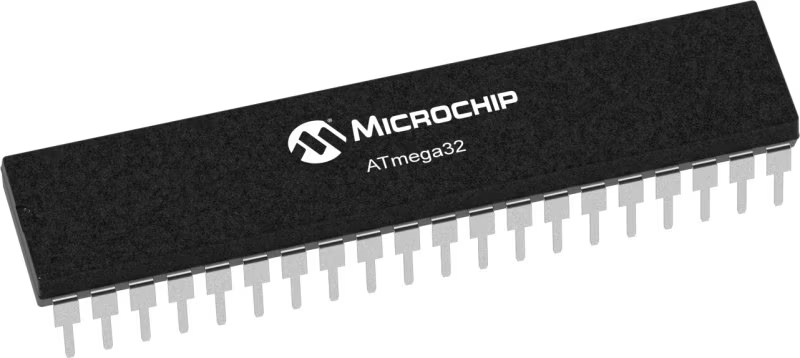
Architecture
AVR
MCU Memory (KB)
32
Silicon Vendor
Microchip
Pin count
40
RAM (Bytes)
2048
Used MCU Pins
mikroBUS™ mapper
Take a closer look
Click board™ Schematic

Step by step
Project assembly
Software Support
Library Description
This library contains API for SRAM 2 Click driver.
Key functions:
sram2_generic_write- Generic write function.sram2_generic_read- Generic read function.sram2_write_protect- Set PWM pin for write protection.
Open Source
Code example
The complete application code and a ready-to-use project are available through the NECTO Studio Package Manager for direct installation in the NECTO Studio. The application code can also be found on the MIKROE GitHub account.
/*!
* \file
* \brief Sram2 Click example
*
* # Description
* This demo application writes and reads from memory.
*
* The demo application is composed of two sections :
*
* ## Application Init
* Initializes driver init.
*
* ## Application Task
* Writes and then reads data from memory.
*
* \author MikroE Team
*
*/
// ------------------------------------------------------------------- INCLUDES
#include "board.h"
#include "log.h"
#include "sram2.h"
// ------------------------------------------------------------------ VARIABLES
static sram2_t sram2;
static log_t logger;
static char rx_data;
static uint8_t message_data[ 9 ] = { 'M', 'i', 'k', 'r', 'o', 'E', 13, 10, 0 };
static uint16_t memory_addr = 0x1234;
// ------------------------------------------------------ APPLICATION FUNCTIONS
void application_init ( void )
{
log_cfg_t log_cfg;
sram2_cfg_t cfg;
/**
* Logger initialization.
* Default baud rate: 115200
* Default log level: LOG_LEVEL_DEBUG
* @note If USB_UART_RX and USB_UART_TX
* are defined as HAL_PIN_NC, you will
* need to define them manually for log to work.
* See @b LOG_MAP_USB_UART macro definition for detailed explanation.
*/
LOG_MAP_USB_UART( log_cfg );
log_init( &logger, &log_cfg );
log_info( &logger, "---- Application Init ----" );
// Click initialization.
sram2_cfg_setup( &cfg );
SRAM2_MAP_MIKROBUS( cfg, MIKROBUS_1 );
sram2_init( &sram2, &cfg );
Delay_ms ( 100 );
}
void application_task ( void )
{
uint8_t cnt;
log_printf( &logger, ">> Write data [ MikroE ] to memory. \r\n" );
sram2_write_protect( &sram2, SRAM2_WR_ENABLE );
Delay_ms ( 10 );
for ( cnt = 0; cnt < 8; cnt++ )
{
sram2_generic_write( &sram2, memory_addr + cnt, message_data[ cnt ] );
Delay_ms ( 10 );
}
Delay_ms ( 1000 );
sram2_write_protect( &sram2, SRAM2_WR_DISABLE );
Delay_ms ( 10 );
log_printf( &logger, ">> Read data from memory. Data : " );
for ( cnt = 0; cnt < 8; cnt++ )
{
sram2_generic_read( &sram2, memory_addr + cnt, &rx_data );
Delay_ms ( 10 );
log_printf( &logger, " %c ", rx_data );
Delay_ms ( 100 );
}
log_printf( &logger, " \r\n" );
log_printf( &logger, "-------------------------------- \r\n" );
Delay_ms ( 1000 );
Delay_ms ( 1000 );
}
int main ( void )
{
/* Do not remove this line or clock might not be set correctly. */
#ifdef PREINIT_SUPPORTED
preinit();
#endif
application_init( );
for ( ; ; )
{
application_task( );
}
return 0;
}
// ------------------------------------------------------------------------ END






















